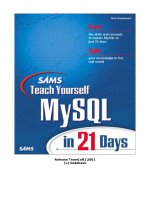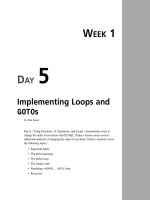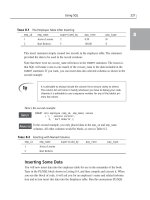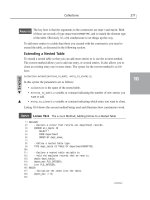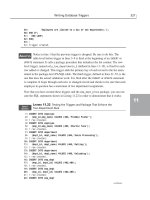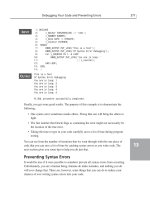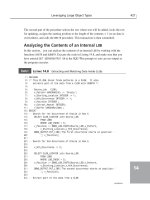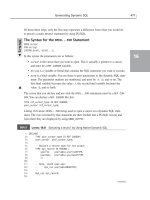Tài liệu Teach Yourself PL/SQL in 21 Days- P4 pptx
Bạn đang xem bản rút gọn của tài liệu. Xem và tải ngay bản đầy đủ của tài liệu tại đây (2.57 MB, 50 trang )
D
AY
5
W
EEK
1
Implementing Loops and
GOTO
s
by Tom Luers
Day 4, “Using Functions,
IF
Statements, and Loops,” demonstrates ways to
change the order of execution with PL/SQL. Today’s lesson covers several
additional methods of changing the order of execution. Today’s material covers
the following topics:
•Statement labels
• The
GOTO
statement
• The
WHILE
loop
• The simple
LOOP
• Emulating a
REPEAT...UNTIL
loop
• Recursion
07 7982 ch05 11.8.00 11:23 AM Page 127
Please purchase PDF Split-Merge on www.verypdf.com to remove this watermark.
Exploring Labels and the
GOTO
Statement
The
GOTO
statement allows for unconditional branching to a statement label. You will first
learn about statement labels, which are necessary to include before you can even use the
GOTO
statement.
Statement Labels
Statement labels are identifiers of a block of code that is similar to a function, but they
are not actual PL/SQL statements. The
GOTO
statement can directly access these labels. In
addition, these labels can be accessed by loops, which are covered in the section “The
EXIT
and
EXIT WHEN
Statements.” The format of a label is
<<label_name>>
Notice two things about the label:
• The label is surrounded by double brackets (
<<
).
• The label must not have a semicolon after the label name.
The label name does not contain a semicolon because it is not a PL/SQL statement, but
rather an identifier of a block of PL/SQL code.
128 Day 5
Labels can’t take the place of required statements therefore you must have
at least one statement after the label or an error results. If your intention is
to execute the code after a label, you should re-evaluate your code decisions
and choose an alternate method such as a function.
Caution
The
GOTO
Statement
The
GOTO
statement enables you to immediately transfer control to another labeled
PL/SQL block without the need for conditional checking. As soon as the
GOTO
statement
is encountered, all control is transferred to the code following the matching
label_name
.
This target label can appear anywhere in the same block of code.
The Syntax for the
GOTO
Statement
GOTO label_name;
The
label_name
is the matching
label_name
that must be contained within the same
PL/SQL block of code.
S
YNTAX
07 7982 ch05 11.8.00 11:23 AM Page 128
Please purchase PDF Split-Merge on www.verypdf.com to remove this watermark.
Implementing Loops and
GOTO
s 129
5
Scoping Rules for the
GOTO
Statement
The
GOTO
destination must be in the same block, at the same level as, or higher than the
GOTO
statement itself. This means that the label must be within the same scope as the
GOTO
statement itself. Conditions that cause Oracle to not compile the PL/SQL code
include
•Jumping into a subblock
•Jumping into a loop
•Jumping into an
IF
statement
•Using
GOTO
to jump from one part of an
IF
statement to another
•Jumping from an exception handler back to a current block of PL/SQL code
You encounter the following error message if you do not follow the proper coding of
GOTO
statements and their labels:
PLS-00375: illegal GOTO statement; this GOTO cannot branch to label
If you want a more global approach, using stored functions is one appropriate method.
Jumping into a Lower-Level Block
You can’t jump from an outer block of PL/SQL code back to an inner block of PL/SQL
code. Listing 5.1 is an example of an illegal
GOTO
call.
The following listing, and the next few after it, is for illustration purposes
only. Due to the errors they generate, you might not want to enter and exe-
cute them. However, if you do enter and execute these listings, they will not
destroy anything, and they might help you to troubleshoot errors in your
code in the future because you can see what errors these listings generate.
Caution
L
ISTING
5.1
Illegal GOTO Call to an Inner Block
1: DECLARE
2: v_Emergency_Warning VARCHAR2(50);
3: v_Status NUMBER = 0;
4: BEGIN
5: GOTO Emergency_Check;
6: BEGIN
7: <<Emergency_Check>>
8: IF v_Status = 1 THEN
9: DBMS_OUTPUT PUT_LINE(‘Emergency!’);
10: END IF;
11: END;
12: END;
I
NPUT
07 7982 ch05 11.8.00 11:23 AM Page 129
Please purchase PDF Split-Merge on www.verypdf.com to remove this watermark.
In Listing 5.1, you see the first block of PL/SQL code noted by a
BEGIN
state-
ment. The block then calls the PL/SQL
GOTO
statement, which attempts to trans-
fer control to the
<<Emergency Check>>
label. Because the label is within a separate
block of PL/SQL code noted by another
BEGIN
statement, it is out of the required scope
of the
GOTO
statement. If, instead of the keyword
BEGIN
,an
<<Emergency_Check>>
label
appeared within the first block, everything would compile and execute properly (barring
errors in the logic of the code).
Jumping into a Loop
The scope of the loop is not complete until the entire range of the loop has completed.
Therefore, attempting to jump into the middle of the loop is illegal. Listing 5.2 shows an
attempt to make an illegal call into a
FOR
loop.
130 Day 5
A
NALYSIS
The following listing is another that serves illustration purposes only
because it generates several errors. You might or might not want to enter
and execute this listing, depending on whether you want to see what kinds
of errors it generates.
Caution
L
ISTING
5.2
Illegal GOTO Call to a Loop
1: BEGIN
2: GOTO insideloop;
3: FOR v_loopcounter IN 1..5 LOOP
4: <<insideloop>
5: DBMS_OUTPUT.PUT_LINE(‘Loop counter is ‘ || v_loopcounter);
6: END LOOP;
7: END;
Error at Line 2
ORA-06550 Line 2
PLS-00201: Identifier ‘insideloop’ must be declared
As you can see, although the loop and the GOTO statement are within the same
block of PL/SQL code, Oracle does not know how to handle the jump inside the
loop. The obvious question is “What is the value of the loop counter?” Because there is
no answer, any attempt to implement this logic results in a compile error.
I
NPUT
O
UTPUT
A
NALYSIS
07 7982 ch05 11.8.00 11:23 AM Page 130
Please purchase PDF Split-Merge on www.verypdf.com to remove this watermark.
Implementing Loops and
GOTO
s 131
5
Jumping into an
IF
Statement
Another illegal attempt to use the
GOTO
statement is to jump inside an
IF
statement.
Listing 5.3 provides an example of another illegal call.
The following listing serves illustration purposes only because it generates
several errors. You might or might not want to enter and execute this list-
ing, depending on whether you want to see what kinds of errors it gener-
ates.
Caution
L
ISTING
5.3
Illegal GOTO Call Inside an IF Statement
1: DECLARE
2: v_Emergency_Warning VARCHAR2(50);
3: v_Status NUMBER = 0;
4: v_ReactorStatus VARCHAR2(10);
5: BEGIN
6: GOTO Emergency_Check;
7: IF v_ReactorStatus = ‘Very Hot’ THEN
8: <<Emergency_Check>>
9: DBMS_OUTPUT PUT_LINE(‘Emergency!’);
10: END IF;
11: END;
From the
GOTO
call in Listing 5.3, if this block of PL/SQL code were allowed to
actually execute, it would never check to see whether
v_ReactorStatus = ‘Very
Hot’
. There might not even be an emergency because
v_ReactorStatus
could have a
value of
‘Cool’
. Because the value is never evaluated, the program always goes into cri-
sis mode. Fortunately, this improper use of
GOTO
is not allowed!
Jumping from One Part of an
IF
Statement to Another
Although you can call a label from an
IF
statement, it is illegal for the jump to go from
the
IF
clause to the
THEN
clause. Listing 5.4 is yet another example of a label not being
within the same scope as the
GOTO
.
I
NPUT
A
NALYSIS
07 7982 ch05 11.8.00 11:23 AM Page 131
Please purchase PDF Split-Merge on www.verypdf.com to remove this watermark.
L
ISTING
5.4
Illegal GOTO Call from One Clause of an IF Statement to
Another Clause
1: DECLARE
2: v_Emergency_Warning VARCHAR2(50);
3: v_Status NUMBER = 0;
4: v_ReactorStatus VARCHAR2(10);
5: BEGIN
6: IF v_ReactorStatus = ‘Very Hot’ THEN
7: GOTO Emergency_Check;
8: ELSE
9: <<Emergency_Check>>
10: DBMS_OUTPUT PUT_LINE(‘Emergency!’);
11: END IF;
12: END;
As Listing 5.4 suggests, the program jumps from an evaluation of the
IF
statement as
true to executing code as if the entire statement were false. This is a definite misuse of
the
GOTO
statement, and the code in this case probably does not require a
GOTO
statement.
From Listing 5.5, it should be apparent that you can’t raise an error and then return to the
original block of code where the error was generated from the exception handler.
132 Day 5
The following listing is another that serves illustration purposes only
because it generates several errors. You might or might not want to enter
and execute this listing, depending on whether you want to see what kinds
of errors it generates.
Caution
I
NPUT
The following listing is another that serves illustration purposes only
because it generates several errors. You might or might not want to enter
and execute this listing, depending on whether you want to see what kinds
of errors it generates.
Caution
L
ISTING
5.5
Illegal GOTO Call from an Exception Handler
1: DECLARE
2: v_Emergency_Warning VARCHAR2(50);
3: v_Status NUMBER = 0;
4: v_ReactorStatus VARCHAR2(10);
5: BEGIN
6: <<Emergency_Check>>
7: PANIC();
8: EXCEPTION
I
NPUT
07 7982 ch05 11.8.00 11:23 AM Page 132
Please purchase PDF Split-Merge on www.verypdf.com to remove this watermark.
Implementing Loops and
GOTO
s 133
5
9: WHEN e_TOOHOT THEN
10: GOTO Emergency_Check;
11: END;
An Example of the
GOTO
Statement in Action
So far, you have seen conditions that exceed the scope of the
GOTO
statement. Now, how
about an example of a legitimate block of PL/SQL code? See Listing 5.6 for a proper
GOTO
.
L
ISTING
5.6
Example of a Proper GOTO Statement
1: DECLARE
2: v_Status NUMBER := 1;
3: BEGIN
4: IF v_Status = 1 THEN
5: GOTO mybranch;
6: ELSE
7: v_Status := 1;
8: END IF;
9: <<mybranch>>
10: NULL;
11: END;
In the
GOTO
example from Listing 5.6, the program checks the value of
v_Status
.
If the value is equal to
1
,then the program goes immediately to the block
<<mybranch>>
; if the value is
false
,the program changes the value of
v_Status
to
equal
1
.
Why Use the
GOTO
Statement?
As in any procedural language, the use of
GOTO
statements is highly discouraged. As you
saw from the listings earlier in the lesson,
GOTO
statements are easy to code improperly.
In almost all cases, your code can and should be written to avoid the use of
GOTO
. There
are several reasons not to use the
GOTO
statement:
• It is easy to make logic errors when using
GOTO
.
• It is easy to make coding errors even when you are trying to make the process
work.
I
NPUT
A
NALYSIS
07 7982 ch05 11.8.00 11:23 AM Page 133
Please purchase PDF Split-Merge on www.verypdf.com to remove this watermark.
• If you use multiple
GOTO
statements, your code jumps all over the place out of
sequence, which is known as spaghetti code. Using multiple
GOTO
s not only causes
longer execution times, but also leads to confusion when you review your code and
make changes.
•Almost all cases in which you use the
GOTO
statement can be written with other
Oracle constructs.
Perhaps the only proper use of
GOTO
statements is to immediately stop all other execution
of statements and branch to a section of code to handle an emergency situation.
WHILE
Loops
The
WHILE
loop enables you to evaluate a condition before a sequence of statements is
executed. In fact, if the condition is false, the code is never executed. This situation is
different from the
FOR
loop where you must execute the loop at least once.
The Syntax for the
WHILE
Loop
The syntax of the
WHILE
loop is
WHILE <condition is true> LOOP
<statements>
END LOOP;
The
WHILE
loop requires the keywords
LOOP
and
END LOOP
to designate the statements to
execute.
134 Day 5
,
S
YNTAX
,
WHILE
loops are invaluable because the program does not have to ever exe-
cute the code within the
LOOP
parameters. This is one fact I cannot stress
enough!
Note
Examples of
WHILE
Loops
All the
WHILE
loop examples are meant to be entered and executed so that you can get
some experience coding
WHILE
loops.
When you first sign on to the database, it is a good idea to create a login
script—or else you can make a habit of typing and executing the statement
SET SERVEROUTPUT ON
. When you learn about the
DBMS_OUTPUT
package on
Day 17, “Writing to Files and the Display,” using this statement allows you
to see the actual output as the PL/SQL code executes to make PL/SQL easier
to understand.
Note
07 7982 ch05 11.8.00 11:23 AM Page 134
Please purchase PDF Split-Merge on www.verypdf.com to remove this watermark.
Implementing Loops and
GOTO
s 135
5
You can enter the loops directly or use the
EDIT
command to save a file, which can be
executed at any time. Listing 5.7 demonstrates how the conditions for a
WHILE
loop can
cause the loop to never execute.
L
ISTING
5.7
Example of a WHILE Loop That Never Executes
1: DECLARE
2: v_Calc NUMBER := 0;
3: BEGIN
4: WHILE v_Calc >= 10 LOOP
5: v_Calc := v_Calc + 1;
6: DBMS_OUTPUT.PUT_LINE(‘The value of v_Calc is ‘ || v_Calc);
7: END LOOP;
8: END;
9: /
In Listing 5.7, the condition is never evaluated to true. The condition
v_Calc
>= 10
from line 4 is never true because
v_Calc
is initialized at line 2 to a value
of
0
, which is less, not greater, than
10
. When Listing 5.7 is executed, no output is sent to
the screen.
Listing 5.8 shows the corrected version of this
WHILE
loop.
L
ISTING
5.8
Corrected WHILE Loop That Executes
1: DECLARE
2: v_Calc NUMBER := 0;
3: BEGIN
4: WHILE v_Calc <= 10 LOOP
5: v_Calc := v_Calc + 1;
6: DBMS_OUTPUT.PUT_LINE(‘The value of v_Calc is ‘ || v_Calc);
7: END LOOP;
8: END;
9: /
The value of v_Calc is 1
The value of v_Calc is 2
The value of v_Calc is 3
The value of v_Calc is 4
The value of v_Calc is 5
The value of v_Calc is 6
The value of v_Calc is 7
The value of v_Calc is 8
The value of v_Calc is 9
The value of v_Calc is 10
The value of v_Calc is 11
I
NPUT
A
NALYSIS
I
NPUT
O
UTPUT
07 7982 ch05 11.8.00 11:23 AM Page 135
Please purchase PDF Split-Merge on www.verypdf.com to remove this watermark.
To make the
WHILE
loop execute, I simply changed the
>=
to
<=
in line 4. The
loop executes at least once because
v_Calc <= 10
.
It is important to understand that the loop continues to execute until
v_Calc > 10
. This
is a potential source of logic error flaws if the intent was to enter the loop until
v_Calc
had a value of
10
and not
11
.
136 Day 5
A
NALYSIS
When debugging loops, in general it is a good idea to use Oracle’s
DBMS_OUTPUT
package to track the flow of the logic. It is a great help when
testing all possible outcomes to make sure that the logic portion is working
properly. A full discussion of this package occurs on Day 17.
Tip
Listing 5.9 illustrates how to step through a
WHILE
loop in increments other than one.
L
ISTING
5.9
Stepping Through a WHILE Loop
1: DECLARE
2: v_Radius NUMBER := 2;
3: BEGIN
4: WHILE v_Radius <=10 LOOP
5: DBMS_OUTPUT.PUT_LINE(‘The Area is ‘ ||
6: 3.14 * v_Radius * v_Radius);
7: v_Radius := v_Radius + 2 ; — Calculates Area for Even Radius
8: END LOOP;
9: END;
10: /
The Area is 12.56
The Area is 50.24
The Area is 113.04
The Area is 200.96
The Area is 314
On Day 4, you created a method to trick Oracle into stepping through a
FOR
loop.
The
WHILE
loop gives you more flexibility in looping, whether you are stepping
through a loop or even executing a loop. Listing 5.9 demonstrates stepping through the
loop. This sequence increments
v_Radius
by a value of
2
from line 7 until it is equal to
10
from the condition specified in line 4.
I
NPUT
O
UTPUT
A
NALYSIS
07 7982 ch05 11.8.00 11:23 AM Page 136
Please purchase PDF Split-Merge on www.verypdf.com to remove this watermark.
Implementing Loops and
GOTO
s 137
5
The next
WHILE
loop is contained in a function. This arrangement allows you to review
functions from Day 4. If you run into any problems, it doesn’t hurt to review the previ-
ous lesson. Create the stored function from Listing 5.10.
L
ISTING
5.10
The WHILE Loop as Part of a Function
1: CREATE OR REPLACE function dontcountsp(p_pass_string VARCHAR2)
2: RETURN NUMBER IS
3: v_MYCOUNTER INTEGER := 1;
4: v_COUNTNOSP NUMBER := 0;
5: BEGIN
6: WHILE v_MYCOUNTER <= LENGTH(p_PASS_STRING) LOOP
7: IF SUBSTR(p_PASS_STRING,v_MYCOUNTER,1) != ‘ ‘ THEN
8: v_COUNTNOSP := v_COUNTNOSP + 1;
9: ELSE
10: NULL;
11: END IF;
12: v_MYCOUNTER := v_MYCOUNTER + 1;
13: END LOOP;
14: RETURN v_COUNTNOSP ;
15: END dontcountsp;
16: /
You create a function called
dontcountsp
from Listing 5.10, which counts all
characters except spaces from a variable-length string up to 20 characters long.
The function is passed a string from
p_PASS_STRING
called from the procedure. The
return type in line 14 is simply a number telling you how many characters are actually
contained in the string.
Of the two variables,
v_MYCOUNTER
holds the positional location for the current location
in the string.
V_COUNTNOSP
holds the total count of characters that are not spaces.
The program finally enters the
WHILE
loop. The loop continues to execute as long as
v_MYCOUNTER
is less than the total
LENGTH
of the string. In the body of the loop, the pro-
gram checks each character, beginning at position one all the way to the length of the
string, and checks for the value of a space, defined by
‘ ‘
. If the value in a position is
not a space, the program increments
v_COUNTNOSP
by 1. If the value is a space, the pro-
gram does nothing, as indicated by the
NULL
statement. The placeholder in the string
v_MYCOUNTER
is then incremented by 1, and the loop continues to execute until it reaches
the end of the string. To see the function in action, type the procedure in Listing 5.11 and
then execute it.
I
NPUT
A
NALYSIS
07 7982 ch05 11.8.00 11:23 AM Page 137
Please purchase PDF Split-Merge on www.verypdf.com to remove this watermark.
L
ISTING
5.11
Executing the WHILE Loop Function
1: DECLARE
2: v_MYTEXT VARCHAR2(20) := ‘THIS IS A TEST’;
3: BEGIN
4: DBMS_OUTPUT.PUT_LINE(‘Total count is ‘ || dontcountsp(v_MYTEXT));
5: END;
6: /
The code in Listing 5.11 creates a variable called
v_MYTEXT
and assigns it a value
of
‘THIS IS A TEST’
in line 2. It then outputs to the screen the total count of
characters not including spaces in line 4.
138 Day 5
I
NPUT
A
NALYSIS
Both the
SUBSTR()
function and the
LENGTH()
function are covered on Day 6,
“Using Oracle’s Built-In Functions.”
Note
The
EXIT
and
EXIT WHEN
Statements
The
EXIT
and
EXIT WHEN
statements enable you to escape out of the control of a loop.
When an
EXIT
statement is encountered, the loop completes immediately and control is
passed to the next statement. The format of the
EXIT
loop is
EXIT;
To terminate a loop, simply follow your condition with the
EXIT
statement. This method
is common in
IF
statements.
The Syntax for the
EXIT WHEN
Loop
The syntax of the
EXIT WHEN
statement is
EXIT WHEN <condition is true>;
The
EXIT WHEN
statement enables you to specify the condition required to exit the execu-
tion of the loop. In this case, no
IF
statement is required. When this statement is encoun-
tered, the condition of the when clause is evaluated. If the clause equates to true, then the
loop exits; otherwise, the looping continues.
S
YNTAX
07 7982 ch05 11.8.00 11:23 AM Page 138
Please purchase PDF Split-Merge on www.verypdf.com to remove this watermark.
Implementing Loops and
GOTO
s 139
5
Examples Using
EXIT
and
EXIT WHEN
In this lesson, you created a
WHILE
loop that incremented by a value of
2
to calculate the
area of a circle. You will change this code so that the program exits when the value of the
radius is 10 after you have calculated the area. Enter and execute the code in Listing
5.12.
L
ISTING
5.12
Using EXIT with a WHILE Loop
1: DECLARE
2: v_Radius NUMBER := 2;
3: BEGIN
4: WHILE TRUE LOOP
5: DBMS_OUTPUT.PUT_LINE(‘The Area is ‘ ||
6: 3.14 * v_Radius * v_Radius);
7: IF v_Radius = 10 THEN
8: EXIT;
9: END IF;
10: v_Radius := v_Radius + 2 ; — Calculates Area for Even Radius
11: END LOOP;
12: END;
13: /
Notice that the output is the same as the
WHILE
loop output from Listing 5.9.
You will find as a programmer that using the
EXIT WHEN
statement will save
you time. This statement requires less coding than the other looping state-
ments. One typical reason you use nested
IF
statements is for fine-tuning
Oracle to speed up the process.
Tip
I
NPUT
It’s important to make sure that the statements are in the correct order for
the proper logic to be performed. If you switch the
DBMS_OUTPUT
statement
and the
IF
statement, the
DBMS_OUTPUT
statement produces only four values
instead of five because the loop exits before the area is printed to the
screen. If you write records to a table, you can easily see how incorrect data
can be written to a table. Test with the
DBMS_OUTPUT
package as described in
Day 17.
Note
07 7982 ch05 11.8.00 11:23 AM Page 139
Please purchase PDF Split-Merge on www.verypdf.com to remove this watermark.
Switching the output statements with the
IF
statement from Listing 5.12, which alters
your output, is illustrated in the following code:
IF v_Radius = 10 THEN
EXIT;
END IF;
DBMS_OUTPUT.PUT_LINE(‘The Area is ‘ || 3.14 * v_Radius * v_Radius);
Logic errors cause the most problems in any coding situation and can be difficult to
resolve. Next, you will see how to code
EXIT WHEN
instead of
EXIT
in Listing 5.13 to
achieve the same results.
L
ISTING
5.13
Using EXIT WHEN with a WHILE Loop
1: DECLARE
2: v_Radius NUMBER := 2;
3: BEGIN
4: WHILE TRUE LOOP
5: DBMS_OUTPUT.PUT_LINE(‘The Area is ‘ ||
6: 3.14 * v_Radius * v_Radius);
7: EXIT WHEN v_RADIUS = 10;
8: v_Radius := v_Radius + 2 ; — Calculates Area for Even Radius
9: END LOOP;
10: END;
11: /
Listing 5.13 performs the same function as Listing 5.12 but uses the
EXIT WHEN
statement on one line, instead of the multiple lines of
IF...THEN...EXIT
state-
ments from Listing 5.12. This version is easier to read and understand.
If you can exit from a
WHILE
loop, you should be able to exit from a
FOR
loop. The code
from Listing 5.14 performs the same function as the code from Listings 5.9, 5.12, and
5.13 to calculate the area of a circle but this time uses a
FOR
loop.
L
ISTING
5.14
Using EXIT with a FOR Loop
1: BEGIN
2: FOR v_loopcounter IN 1..20 LOOP
3: IF MOD(v_loopcounter,2) = 0 THEN
4: DBMS_OUTPUT.PUT_LINE(‘The AREA of the circle is ‘ ||
5: v_loopcounter*v_loopcounter * 3.14);
6: END IF; — End execution of statements for even counter
7: IF v_loopcounter = 10 THEN
8: EXIT;
9: END IF;
10: END LOOP;
11: END;
12: /
140 Day 5
I
NPUT
A
NALYSIS
I
NPUT
07 7982 ch05 11.8.00 11:23 AM Page 140
Please purchase PDF Split-Merge on www.verypdf.com to remove this watermark.
Implementing Loops and
GOTO
s 141
5
The loop terminates after the area has been calculated for a radius of 10 from
line 7. Notice that the
IF
condition from line 7 fully terminates the loop pre-
maturely before the loop can increment to a value of
20
.
If you exit out of a loop in the middle of the function, what happens? To see the out-
come, first enter the code in Listing 5.15 to create the function called
exitfunc
.
L
ISTING
5.15
Impact of EXIT in a Function
1: CREATE OR REPLACE function exitfunc(p_pass_string VARCHAR2)
2: RETURN NUMBER IS
3: v_MYCOUNTER INTEGER := 1;
4: v_COUNTNOSP NUMBER := 0;
5: BEGIN
6: WHILE v_MYCOUNTER <= LENGTH(p_PASS_STRING) LOOP
7: IF SUBSTR(p_PASS_STRING,v_MYCOUNTER,1) != ‘ ‘ THEN
8: v_COUNTNOSP := v_COUNTNOSP + 1;
9: ELSE
10: NULL;
11: END IF;
12: v_MYCOUNTER := v_MYCOUNTER + 1;
13: EXIT WHEN SUBSTR(p_PASS_STRING,v_MYCOUNTER,1) = ‘ ‘;
14: END LOOP;
15: RETURN v_COUNTNOSP ;
16: END exitfunc;
17: /
Notice the addition of only one statement that tells the program to exit the loop if
it encounters a space. To test and execute the function, enter the code from
Listing 5.16.
L
ISTING
5.16
Executing EXIT Within a Function
1: DECLARE
2: v_MYTEXT VARCHAR2(20) := ‘THIS IS A TEST’;
3: BEGIN
4: DBMS_OUTPUT.PUT_LINE(‘Total count is ‘ || exitfunc(v_MYTEXT));
5: END;
6: /
The output when executed should be
Total count is 4
A
NALYSIS
I
NPUT
A
NALYSIS
I
NPUT
O
UTPUT
07 7982 ch05 11.8.00 11:23 AM Page 141
Please purchase PDF Split-Merge on www.verypdf.com to remove this watermark.
The effect of breaking out of a loop in the function is that it still returns the
value of the variable when the
EXIT
statement has been executed. Instead of
counting all the characters in the line, it stops when it hits the first space and properly
returns the value of
4
for the word
‘Test’
.
142 Day 5
A
NALYSIS
If you do use the
EXIT
or
EXIT WHEN
statement in a loop, make sure to
always initialize the parameters. This way, some value always returns even if
the loop never executes.
Tip
Using Labels and
EXIT
Statements with Loops
You can use labels within loops to identify a loop. When you’re nesting loops, labels help
to document the code.
The Syntax for Using Labels with Loops
<<label_name1>>
LOOP
<<label_name2>>
LOOP
...
END LOOP <<label_name2>>
END LOOP <<label_name1>>
You will use the example of nested
FOR
loops from Day 4 (Listing 4.15) and modify it
with label names, as shown in Listing 5.17.
L
ISTING
5.17
Using Labels with Loops
1: BEGIN
2: <<outerloop>>
3: FOR v_outerloopcounter IN 1..2 LOOP
4: <<innerloop>>
5: FOR v_innerloopcounter IN 1..4 LOOP
6: DBMS_OUTPUT.PUT_LINE(‘Outer Loop counter is ‘ ||
7: v_outerloopcounter ||
8: ‘ Inner Loop counter is ‘ || v_innerloopcounter);
9: END LOOP innerloop;
10: END LOOP outerloop;
11: END;
12: /
The only difference between Listing 4.15 in Day 4 and Listing 5.17 is the use of
the label names
outerloop
and
innerloop
. Otherwise, there is no difference in
execution, output, and so on, but it is much easier to follow the logic.
,
S
YNTAX
,
I
NPUT
A
NALYSIS
07 7982 ch05 11.8.00 11:23 AM Page 142
Please purchase PDF Split-Merge on www.verypdf.com to remove this watermark.
Implementing Loops and
GOTO
s 143
5
You can even change the order of execution of a loop by using the
EXIT
and
EXIT WHEN
statements, as shown in Listing 5.18.
L
ISTING
5.18
Changing Labeled Loop Execution with EXIT Statements
1: BEGIN
2: <<outerloop>>
3: FOR v_outerloopcounter IN 1..2 LOOP
4: <<innerloop>>
5: FOR v_innerloopcounter IN 1..4 LOOP
6: DBMS_OUTPUT.PUT_LINE(‘Outer Loop counter is ‘
7: || v_outerloopcounter ||
8: ‘ Inner Loop counter is ‘ || v_innerloopcounter);
9: EXIT outerloop WHEN v_innerloopcounter = 3;
10: END LOOP innerloop;
11: END LOOP outerloop;
12: END;
13: /
When you run the code in Listing 5.18, you should see the following output:
Outer Loop counter is 1 Inner Loop counter is 1
Outer Loop counter is 1 Inner Loop counter is 2
Outer Loop counter is 1 Inner Loop counter is 3
The
EXIT WHEN
statement directs the program to exit the outer loop when the
inner loop reaches a value of 3. Notice that this completely aborts the execution
of both loops.
Simple
LOOP
s
The final loop to discuss today is the simple
LOOP
. This type of loop is the simplest to
use and understand out of all the loops. The Simple Loop is a simple variation of the
other loops presented.
The Syntax for a Simple
LOOP
The syntax of the simple
LOOP
is
LOOP
<statement(s)>
END LOOP;
If you do not have an
EXIT
or
EXIT WHEN
statement located in the loop, you have an infi-
nite loop.
I
NPUT
O
UTPUT
A
NALYSIS
S
YNTAX
07 7982 ch05 11.8.00 11:23 AM Page 143
Please purchase PDF Split-Merge on www.verypdf.com to remove this watermark.
Sample Simple
LOOP
s
144 Day 5
When using
EXIT
or
EXIT WHEN
, always place these commands either at the
beginning of the
LOOP
block or at the end of the
LOOP
block. This way, you
can avoid many logic errors.
Tip
The following is an example of an infinite loop. You probably do not want
to execute this example. As you can see, the loop never ends and never does
anything!
Caution
BEGIN
LOOP
NULL;
END LOOP;
END;
/
You can properly exit out of a loop by simply adding the word
EXIT
after the
NULL
state-
ment. Execute the code in Listing 5.19.
L
ISTING
5.19
Using EXIT with a Simple LOOP
1: BEGIN
2: LOOP
3: NULL;
4: EXIT;
5: END LOOP;
6: END;
Creating a
REPEAT...UNTIL
Loop
Oracle does not have a built-in
REPEAT <statements> UNTIL <condition is true>
loop. However, you can simulate one by using the simple
LOOP
and the
EXIT
or
EXIT
WHEN
statements.
I
NPUT
07 7982 ch05 11.8.00 11:23 AM Page 144
Please purchase PDF Split-Merge on www.verypdf.com to remove this watermark.
Implementing Loops and
GOTO
s 145
5
The Syntax for a Simulated
REPEAT...UNTIL
Loop
LOOP
<statements>
IF <condition is true>
EXIT;
END IF;
END LOOP;
Alternatively, you can use the preferable method of
LOOP
<statements>
EXIT WHEN <condition is true>;
END LOOP;
,
S
YNTAX
,
You will find as a programmer that using the
EXIT WHEN
statement will save
your time. This statement requires less coding that the other looping state-
ments. One typical reason you use nested
IF
statements is for fine-tuning
Oracle to speed up the process.
Tip
An Example of a Simulated
REPEAT...UNTIL
Loop
Enter the code in Listing 5.20. You are still calculating the area of a circle as you did in
Listings 5.9, 5.12, 5.13, and 5.14, but this time, you use a simulated
REPEAT...UNTIL
loop.
L
ISTING
5.20
Demonstrating a REPEAT...UNTIL Loop
1: DECLARE
2: v_Radius NUMBER := 2;
3: BEGIN
4: LOOP
5: DBMS_OUTPUT.PUT_LINE(‘The AREA of the circle is ‘
6: || v_RADIUS*v_RADIUS * mypi);
7: v_Radius := v_Radius + 2;
8: EXIT WHEN v_Radius > 10;
9: END LOOP;
10: END;
I
NPUT
07 7982 ch05 11.8.00 11:23 AM Page 145
Please purchase PDF Split-Merge on www.verypdf.com to remove this watermark.
Notice that the code in Listing 5.20 creates the same five output lines computing
the area of the circle that were produced by Listing 5.12. This simulated
REPEAT...UNTIL
loop simply starts the loop, outputs the area of the loop to the screen,
increments the radius, and then exits when the radius is greater than 10. This arrange-
ment allows you to use the values
2
,
4
,
6
,
8
, and
10
as in the other examples.
What Loop Should I Use?
All of these loop options can get confusing! As you saw in the examples, you can use the
FOR
,
WHILE
, and
LOOP
statements to create the same output. However, Table 5.1 shows
some general guidelines about when to use what type of loop.
T
ABLE
5.1
When to Use Which Loop
Loop When to Use It
FOR
Always use the
FOR
loop if you know specifically how many times the loop
should execute. If you have to code an
EXIT
or
EXIT WHEN
statement in a
FOR
loop, you might want to reconsider your code and go with a different loop or
different approach.
WHILE
Use this if you might never even want to execute the loop one time. Although
you can duplicate this result in a
FOR
loop using
EXIT
or
EXIT WHEN
,this situa-
tion is best left for the
WHILE
loop. The
WHILE
loop is the most commonly
used loop because it provides the most flexibility.
LOOP
You can use the simple
LOOP
if you want to create a
REPEAT <statements>
UNTIL <condition is true>
type of loop. The simple
LOOP
is perfect for per-
forming this task.
Loop Guidelines
Some loop guidelines you should follow appear in the following Do/Don’t box.
146 Day 5
A
NALYSIS
07 7982 ch05 11.8.00 11:23 AM Page 146
Please purchase PDF Split-Merge on www.verypdf.com to remove this watermark.

